We Drive the Volkswagen Golf GTI TCR Race Car, the Coolest GTI Ever
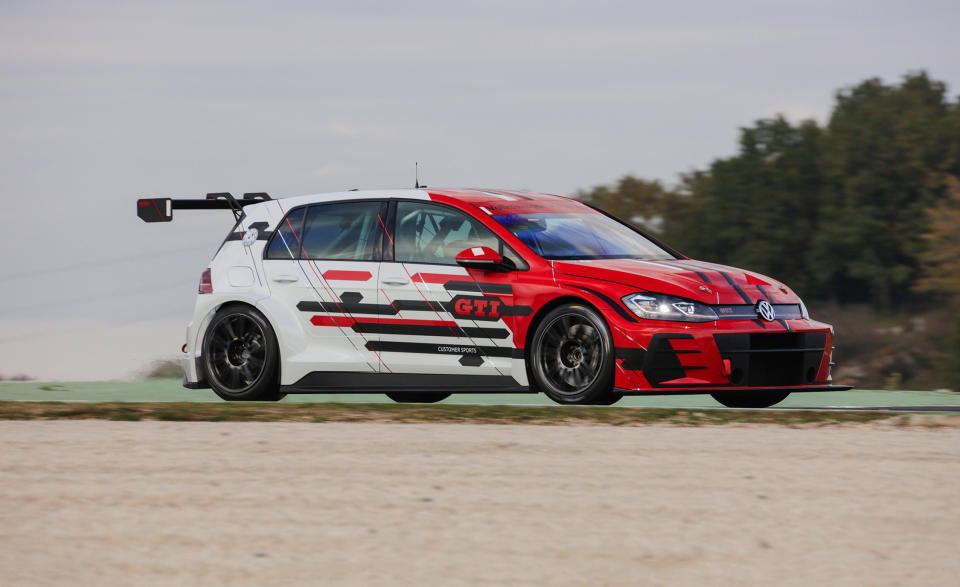
The models racing in various motorsports series have moved too far away from production cars. Take NASCAR, which has become a personality show performed with nearly identical tube-frame cars—even if the new Chevrolet Camaro ZL1 racer is a step in the right direction—or Germany’s DTM, which has moved from a colorful lineup of production-based cars to a contest of largely standardized purpose-built racers. No wonder some racing organizers are looking for remedies. One is the TCR series, conceived by former WTCC boss Marcello Lotti and launched in 2015 with the objective of keeping costs down, the race cars close to their series-production counterparts, and ensuring a competitive field throughout the season.
Yes, there are some questionable quirks in the TCR series: Winners early in the season can be handicapped with weight penalties (charmingly called “success ballast”), so the races are about tactics as much as speed. But generally, the series has been well received by viewers, racers, and the industry. The Volkswagen Group has gone all in, with the Golf GTI TCR, the Audi RS3 LMS, and the SEAT León Cup Racer TCR all competing. On January 26, the Golf GTI TCR made its debut in North America in a support race leading up to the Rolex 24 at Daytona. It didn’t win—that honor was taken by Tom Long and Britt Casey Jr. in an RS3 LMS—but it marked an important entrance for VW as the embattled brand moves more forcefully into customer racing.
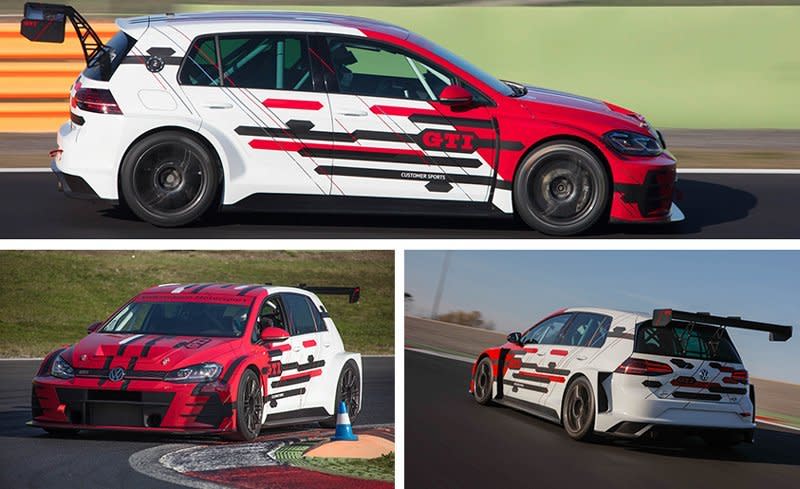
We had the chance to get behind the wheel of a GTI TCR at the Vallelunga racetrack northeast of Rome, Italy. It’s a true race car, but it is very clearly based on an actual vehicle that people can buy. It’s roughly six inches wider than a stock GTI thanks to huge fender flares, and the modifications for the racetrack also include an adjustable rear wing and aggressive front and rear bumpers. Still, this is an actual GTI, not a generic plastic shell with VW stickers.
The interior is bereft of décor and sound deadening, but the dashboard retains a semblance of the production GTI’s. The handbrake’s protruding handle conveniently rises to a position next to the steering wheel. The gear selector looks familiar, and it directs VW’s familiar seven-speed DSG dual-clutch automatic. The DSG is a curiously unpopular choice among GTI TCR customers, who prefer the also available six-speed sequential racing gearbox by a huge margin, even though the sequential box raises the price by 20,000 euros and is far more prone to damage by mistreatment.
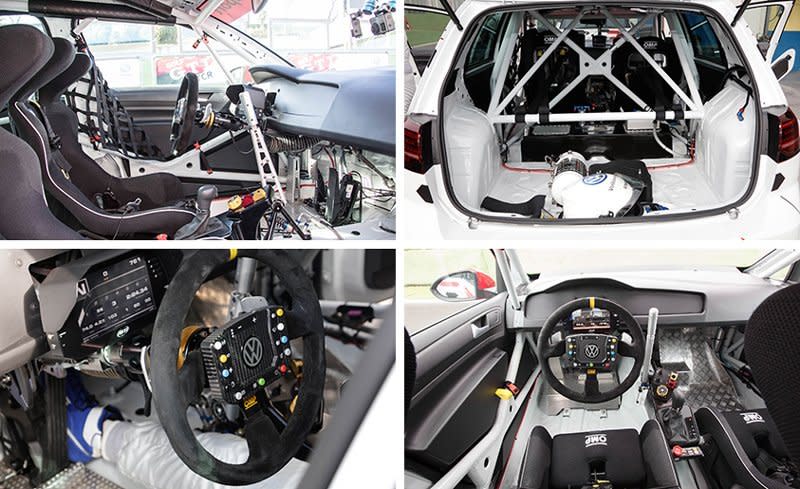
The driving position is familiar and provides for a good idea of the whereabouts of this GTI’s four corners. The racing seat pairs with a five-point harness and head protectors, and there also is an FIA-approved roll cage to minimize the risk of injury in the event of a collision.
The turbocharged, port- and direct-injected 2.0-liter inline-four fires up with a loud bellow and immediately settles into a dark-sounding steady idle. Force-fed by a single turbo, it serves up 350 horsepower at 6200 rpm; maximum torque is 310 lb-ft at a low 2500 rpm. (That’s 130 horsepower and 52 lb-ft more than a standard GTI.) It has to propel a mere 2833 pounds, which is the minimum required by TCR regulations.
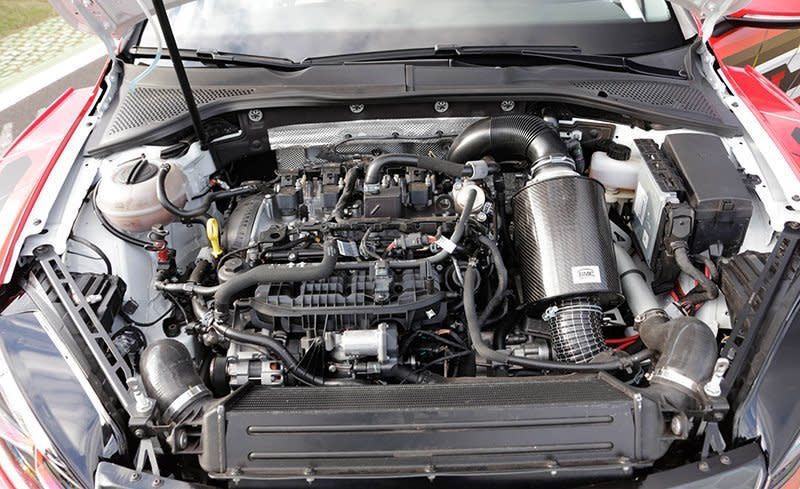
The EA888 engine revs with a vengeance, and its guttural sound makes it feel even more powerful than it is. The sprint from zero to 62 mph takes a claimed 5.2 seconds, and the GTI TCR tops out at 160 mph. That’s not supercar territory, but it’s fast enough for plenty of excitement on the track. Professional racers may find the low torque peak unusual; it invites the driver to stay in taller gears instead of revving to the max.
The modified rack-and-pinion steering is ultra-precise, and turn-in is immediate. On cold days, as when we were at Vallelunga, the biggest danger comes from the rear tires. Given that the torque is transmitted to the front wheels, the rear tires carry a lighter work load and consequently stay relatively cold, keeping grip at low levels. That can become a problem when setting up for tighter corners, when load transfer makes the tail come around in a hurry. At higher speeds, on the other hand, the tail remains firmly planted, thanks in part to the large, adjustable rear wing.
We ran two laps behind racing legend Hans-Joachim Stuck to get a feel for the track, then VW let us loose. Like virtually every race car, the Golf GTI TCR is addictive, and we could have driven for hours in the quest for the perfectly executed lap.
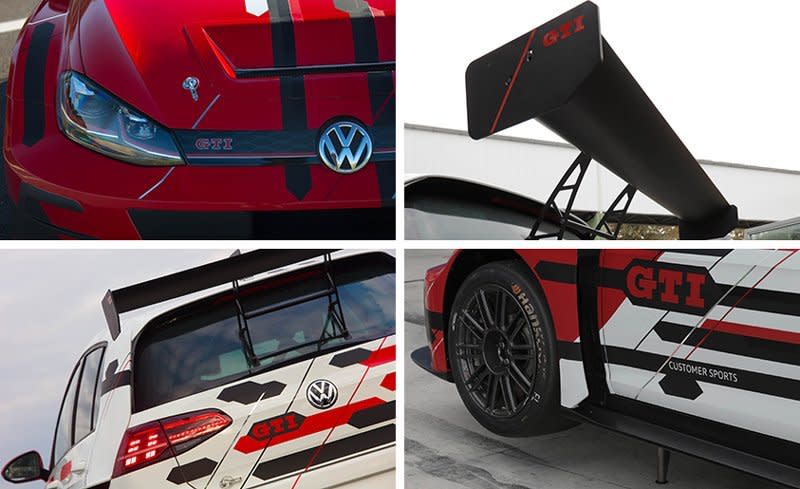
At about $110,000 to start, the Golf GTI TCR is surprisingly accessible for a brand-new racing car, and we are told it is possible to run a season for around $185K. That’s not bad at all for a factory-built, turnkey solution, and it’s made all the more possible by the fact that 65 percent of the car’s parts are carried over from the regular GTI.
Beyond the Audi and the SEAT, the TCR series’ field of homologated cars includes the Alfa Romeo Giulietta, Ford Focus, Honda Civic Type R, Hyundai i30 N, Kia Cee’d, Lada Vesta, Opel Astra, Peugeot 308, Renault Mégane, and Subaru WRX STI. They are all front-wheel drive four-door sedans or hatchbacks, powered by turbocharged engines of up to 2.0 liters. And all are recognizable relatives to the cars ordinary people drive every day. We love all forms of racing, but especially those that are this relatable.

 Yahoo Autos
Yahoo Autos 